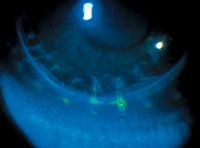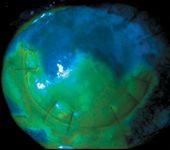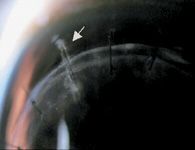Article
Complications after PK should be approached systematically
Compulsive graft management, questions, appropriate differentialdiagnosis are key, surgeon says

Robert S. Feder, MD, highlighted some questions surgeons should ask when faced with these challenges, the differential diagnosis in these situations, and management options at the American Society of Cataract and Refractive Surgery annual meeting.


When there is a negative Seidel test with gentle pressure, he advised that a choroidal effusion with ciliary body detachment should be suspected.
Pupillary block. Alternatively, if the anterior chamber is flat with normal or high IOP, pupillary block might be a possibility. Dilating the pupil breaks the blockage temporarily. Dr. Feder recommended peripheral iridotomy be performed. If an anterior chamber lens is to be implanted, a peripheral iridectomy should be done at the time of surgery.
If aqueous misdirection develops, YAG laser to the anterior hyaloid face is an option, or anterior vitrectomy can also be considered, according to Dr. Feder.
Wound leaks. A wound leak with a formed anterior chamber should be suspected when IOP is less than 10 mm Hg.
"Wound leaks can be within the wound or in the suture track," Dr. Feder said.
He commented that if full-thickness sutures are placed and tied tightly, the wound track can be stretched and, as a result, leak. Dr. Feder also advised that surgeons think about the number of sutures placed or whether they might have been poorly placed.
"It is better to replace a poorly placed suture than to add more sutures," he said.
Treatment includes patching, bandage soft contact lens, and administration of oral acetazolamide to stop the flow of aqueous.
Dr. Feder has what he refers to as the "5-day rule." In a patient with a formed anterior chamber and a small wound leak, Dr. Feder observes the patient for a maximum of 5 days, after which time he repairs the leak surgically.
Suture management and abscess. The key factor with suture management is whether the sutures stain with fluorescein, he said.
"Surgeons should routinely stain the grafted cornea on every postoperative visit to look at the sutures." Dr. Feder said.
Eroded, loose, or broken sutures need to be removed because they are not holding the wound together. This is especially true for patients who are immunosuppressed, because of the risk of development of endophthalmitis. Topical antibiotics should be applied for several days following suture removal.
Newsletter
Don’t miss out—get Ophthalmology Times updates on the latest clinical advancements and expert interviews, straight to your inbox.





